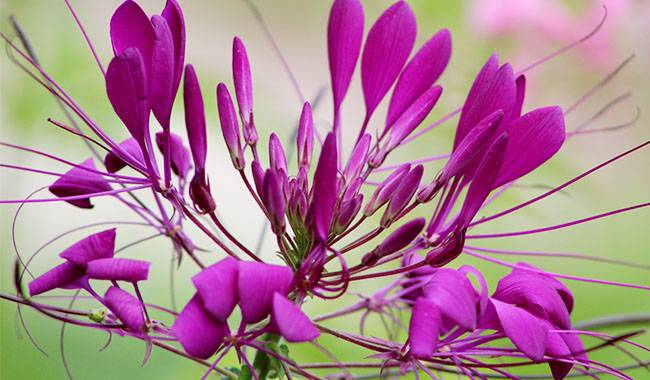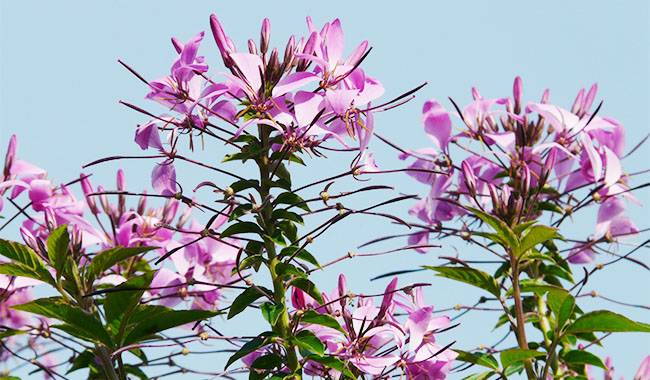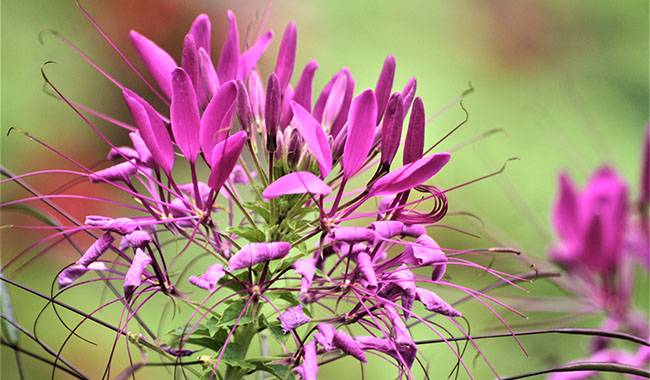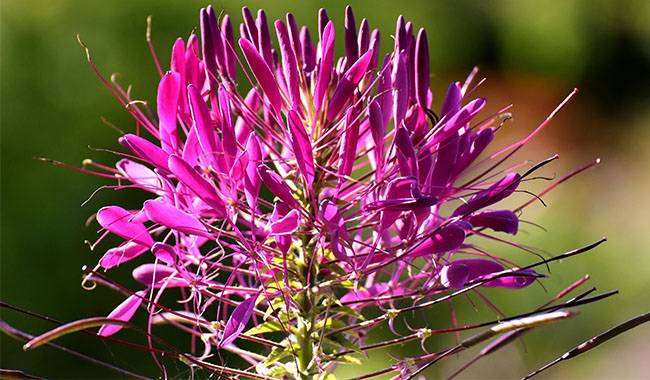
Among the annual flowering species, few plants can match the size of the cleome. It is a unique semi-shrub that is not only beautiful but also surprisingly sticky.
So how to germinate cleome seeds? I’m sure many of you will mention this question.
But the main attraction of cleome is still its “thorny” inflorescence and amazingly temperamental flowers.
Not the easiest of annuals to grow, it will suit anyone looking for an exotic solution in seasonal garden decor. Crema is one of the most original non-winter plants.
WHAT IS CLEOME
Cleome, or Spider flower, is a genus of annual or biennial plants in the family Cleomaceae, growing in warm and temperate climates around the world and numbering about 70 species.
Because of the unusual shape of the inflorescence, the Germans called the cleome “Spider flower”, meaning “spider plant”. The unusual fringe looks like an explosion, a burst of champagne – you may not like this plant, but it is impossible not to pay attention to it.
The spectacular beauty of the flowers, the exotic scent, and the fact that cleome plants bloom throughout the summer from June to September are qualities that are increasingly attracting the attention of florists.
BOTANICAL DESCRIPTION
Cleome has a strong root system, stoutly branched stems, pubescent with short glandular hairs, and reaching a height of 20inch (0.5m).
Leaves are light green, alternate, covered from below with small prickles in some species, simple or compound – with 5 to 7 entire linear slender leaflets upper leaves entire and small.
The decently shaped white, purple, yellow, or pink flowers are clustered at the top in brush-like inflorescences with long stamens that look like spider legs.
The fruits of cleome are single-nested, multi-seeded, pod-like seeds up to 1-1.5inch (2.54-3cm) long. Many beauty lovers are puzzled by the not-so-strong floral scent of cleome, but in the garden, in the fresh air, it is not felt at all but scares away harmful insects. In fact, this scent, in areas where cleome lives naturally, attracts small bats to pollinate the plants.
GROWING CLEOME FROM SEED
How to sow cleome
Propagation by seeds. How to grow cleome from seeds? In spring or under winter. November and December can be sown directly into the ground, but it is better to use the method of propagation from seeds.
So, when to sow cleome seedlings? cleome has a long vegetative period, so if you want to harvest mature seeds in the fall, you need to sow seedlings already at the end of February.
Before sowing cleome seeds, to speed up their germination process, soak them in a growth agent or solution (2 drops of medicine per cup of warm boiling water) for 12 hours, and then sow them in a shallow container with seedling soil (vegetable mix, hummus, and sand in the ratio of 2).
And cover a layer of the same soil with a thickness of 0.6inch (1.5cm) from the top and cover with glass to form a greenhouse effect.
Seedling care
Germination cleome from seeds not soon, after 2-3 weeks, but immediately after sprouting transfer to a light windowsill and organize them for additional lighting at night. Moisturize as needed – not often, but heavily, allowing the soil to dry between waterings.
To prevent root diseases, water the seedlings once with a weak manganese solution.
When the seedlings grow a few true leaves, dig them into peat bog pots and sink them into the ground to become cotyledons. Two weeks after harvesting, the seedlings can be given a light mineral fertilizer and every two weeks thereafter. Rotate the pot from time to time in relation to the light source so that the seedlings do not develop crookedly.
PLANTING CLEOME

When to plant
When the frost has returned, the seedlings can be planted into the ground. Usually, planting time is at the end of May or the beginning of June.
Assign cleome seedlings a sunny spot without strong drafts; they don’t need anything else, although a well-watered cleome grows better on fertile soil with a neutral response than on poor, dry soil.
Therefore, if the soil of a close plot leaves much to be desired, apply a bucket of well-rotted compost and two tablespoons of granular flower fertilizer per square meter under the soil.
How to plant
For better rooting of seedlings in the open ground, spray the seedlings with a solution of stimulant and micronutrient according to the instructions before planting.
Plant cleome in the open ground in pots moistened with peat and spaced 20-27inch (50-70cm) apart. This is done to ensure that the plants are not overgrown with weeds, that the plants are not affected by pests and diseases, and that they bloom abundantly and brightly. After planting, the cleome under the roots is watered with a humic acid solution.
CARE OF CLEOME
Growing conditions
The care of cleome is simple: water only in hot weather, infrequently but sufficiently, fortnightly with a type compound fertilizer under the roots, two tablespoons of fertilizer diluted in 10 liters of water.
Weak and diseased aloe bushes should be nourished with a solution of one teaspoon of fertilizer sprayed on the leaves in three liters of water.
If you can’t wait to see the cleome flowering, you can spray it with a solution of growth agent at a rate of one milliliter of solution per one liter of water before the flower buds begin to form.
In addition to these operations, growing cleome requires removing weeds and loosening the soil if you are too lazy to mulch after planting.
Pests and diseases
Insect pests will not approach the plant due to the fragrance of the flowers. And it rarely gets sick unless you plant it close to groundwater and water it unnecessarily, but since this is unlikely to happen, you can assume that cleome is indestructible.
CLEOME AFTER FLOWERING
How and when to harvest the seeds
Since cleome flowers are cultivated entirely from seed, it is advisable to collect seeds and sow them in autumn when they are ripe, under winter, or in spring.
The maturity of the seeds can be judged by eye: they are round, up to 1.5 mm in diameter, and yellow or brown – depending on the color of the flower.
To avoid missing the moment when the pod’s burst and the seeds spill on the ground, it is best to put several pods in a gauze bag so that the seeds do not fall to the ground, but are inside.
Cleoma in winter
Cleome is an annual plant in our climate, so it is important to treat it after the frost comes.
The seeds collected in autumn can be sown in the ground in November or December to a depth of 0.6inch (1.5cm), then covered and removed when spring comes so that the seeds that have overwintered in the ground can start to grow.





